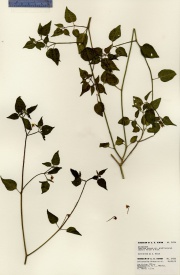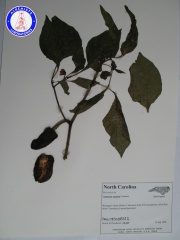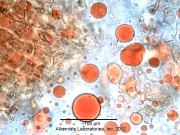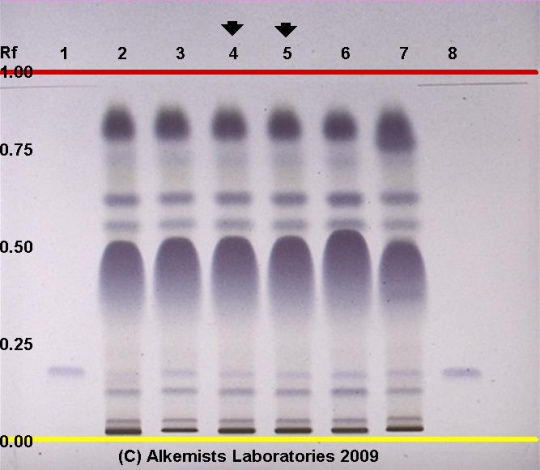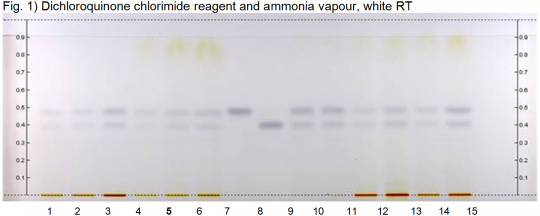Capsicum annuum (fruit)
Contents |
Nomenclature
Capsicum annuum L. var. annuum Solanaceae
Standardized common name (English): cayenne
Introduction
Introduction from Wikipedia, the free encyclopedia (http://en.wikipedia.org/wiki/Capsicum_annuum, retrieved 02/20/2012).
Capsicum annuum is a domesticated species of the plant genus Capsicum native to southern North America and northern South America. The three species C. annuum, C. frutescens and C. chinense all evolved from a single common ancestor located somewhere in the northwest Brazil - Colombia area. This species is the most common and extensively cultivated of the five domesticated Capiscums.
The species is a source of popular sweet peppers and hot chilis with numerous varieties cultivated all around the world. In American English the plant is commonly known as a chili pepper or bell pepper.
In British English, the sweet varieties are called red or green peppers and the hot varieties chillies, whereas in Australian and Indian English the name capsicum is commonly used for bell peppers exclusively and chilli is often used to encompass the hotter varieties.
Sweet peppers are very often used as a bulking agent in ready-made meals and take-away food, because they are cheap, have a strong flavour, and are colorful. The colorful aspect of peppers increases the visual appeal of the food, making it more appetizing. Foods containing peppers, especially chili peppers, often have a strong aftertaste this is due to the presence of capsinoids in peppers. Capsaicin, a chemical found in chili peppers, creates a burning sensation once ingested which can last for several hours after ingestion.
The quoted text in this section was licensed for use under the Creative Commons ShareAlike License, version 3.0: http://creativecommons.org/licenses/by-sa/3.0/
Macroscopic Entries
|
|
Microscopic Entries
|
HPTLC Entries
|
Cayenne (fruit) (Capsicum annuum var. annuum L.) Lane Assignments Lanes, from left to right (Track, Volume, Sample):
Reference materials used here have been authenticated by macroscopic, microscopic &/or TLC studies according to the reference source cited below held at Alkemists Laboratories, Costa Mesa, CA. Stationary Phase Silica gel 60, F254, 10 x 10 cm HPTLC plates Mobile Phase toluene: ethyl acetate [7/3] Sample Preparation Method 0.5g+5ml dichloromethane, sncte/cntrfge/dcnt, evap dry (N2), qs 1.0 ml Toluene Detection Method Vanillin/H2SO4 Reagent -> 110° C 5 min -> Visible light Reference see British Herbal Pharmacopoeia, 1996
|
|
Cayenne pepper (fruit) (Capsicum annum / Capsicum frutescens) Lane Assignments Lanes, from left to right (Track, Volume, Sample):
Reference Sample(s) Reference: Dissolve 2 mg of capsaicin in 5 mL of methanol. Dissolve 2 mg of dihydrocapsaicin in 5 mL of methanol. Stationary Phase Stationary phase, i.e. Silica gel 60, RP-18, F254 Mobile Phase Water, methanol 20:80 (v/v) Sample Preparation Method Sample: Mix 1 g of powdered sample with 10 mL of methanol and sonicate for 10 minutes, then centrifuge or filter the solutions and use the supernatants / filtrates as test solutions. Derivatization reagent: Dichloroquinone chlorimide reagent Preparation: 50 mg dichloroquinone chlorimide in 200 mL of ethyl acetate Use: Dip (time 0, speed 5), dry with cold air for 5 min, then expose to ammonia vapor Detection Method Saturated chamber; developing distance 70 mm from lower edge; relative humidity 33% Other Notes Images presented in this entry are examples and are not intended to be used as basis for setting specifications for quality control purposes. System suitability test: Capsaicin: blue zone at Rf ~ 0.47; Dihydrocapsaicin: blue zone at Rf ~ 0.40 Identification: Compare result with reference images. The fingerprint of the test solution is similar to that of the corresponding botanical reference sample. Additional weak zones may be present. The chromatogram of the test solution shows two blue zones at Rf ~ 0.40 and Rf ~ 0.47.
|
Other Points of Interest
Cite error: <ref> tags exist, but no <references/> tag was found
